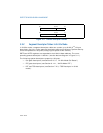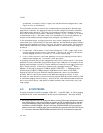
Vol. 3 4-7
PAGING
4.2 HIERARCHICAL PAGING STRUCTURES: AN OVERVIEW
All three paging modes translate linear addresses use hierarchical paging struc-
tures. This section provides an overview of their operation. Section 4.3, Section 4.4,
and Section 4.5 provide details for the three paging modes.
Every paging structure is 4096 Bytes in size and comprises a number of individual
entries. With 32-bit paging, each entry is 32 bits (4 bytes); there are thus 1024
entries in each structure. With PAE paging and IA-32e paging, each entry is 64 bits
(8 bytes); there are thus 512 entries in each structure. (PAE paging includes one
exception, a paging structure that is 32 bytes in size, containing 4 64-bit entries.)
The processor uses the upper portion of a linear address to identify a series of
paging-structure entries. The last of these entries identifies the physical address of
the region to which the linear address translates (called the page frame). The lower
portion of the linear address (called the page offset) identifies the specific address
within that region to which the linear address translates.
Each paging-structure entry contains a physical address, which is either the address
of another paging structure or the address of a page frame. In the first case, the
entry is said to reference the other paging structure; in the latter, the entry is said
to map a page.
The first paging structure used for any translation is located at the physical address
in CR3. A linear address is translated using the following iterative procedure. A
portion of the linear address (initially the uppermost bits) select an entry in a paging
structure (initially the one located using CR3). If that entry references another
paging structure, the process continues with that paging structure and with the
portion of the linear address immediately below that just used. If instead the entry
maps a page, the process completes: the physical address in the entry is that of the
page frame and the remaining lower portion of the linear address is the page offset.
The following items give an example for each of the three paging modes (each
example locates a 4-KByte page frame):
• With 32-bit paging, each paging structure comprises 1024 = 2
10
entries. For this
reason, the translation process uses 10 bits at a time from a 32-bit linear
address. Bits 31:22 identify the first paging-structure entry and bits 21:12
identify a second. The latter identifies the page frame. Bits 11:0 of the linear
address are the page offset within the 4-KByte page frame. (See Figure 4-2 for
an illustration.)
• With PAE paging, the first paging structure comprises only 4 = 2
2
entries.
Translation thus begins by using bits 31:30 from a 32-bit linear address to
identify the first paging-structure entry. Other paging structures comprise
512 =2
9
entries, so the process continues by using 9 bits at a time. Bits 29:21
identify a second paging-structure entry and bits 20:12 identify a third. This last
identifies the page frame. (See Figure 4-5 for an illustration.)
• With IA-32e paging, each paging structure comprises 512 = 2
9
entries and
translation uses 9 bits at a time from a 48-bit linear address. Bits 47:39 identify
the first paging-structure entry, bits 38:30 identify a second, bits 29:21 a third,


















